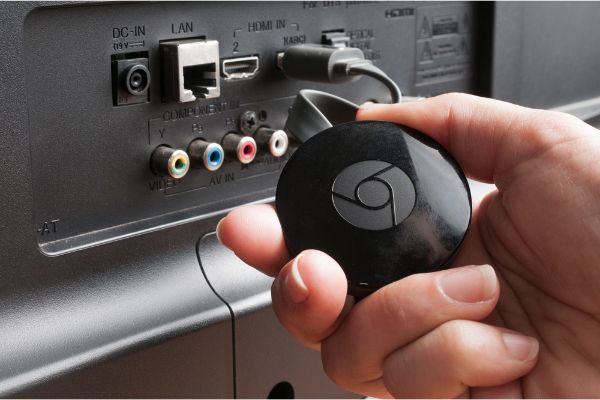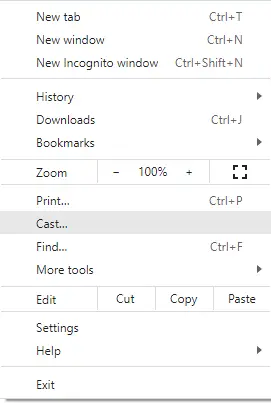Disclaimer: This post may contain affiliate links, meaning we get a small commission if you make a purchase through our links, at no cost to you. For more information, please visit our Disclaimer Page.
You may have been trying to cast videos or photos from your phone or computer to your TV, but found that it just doesn’t work. Don’t worry, you’re not alone!
The most common reasons you cannot cast to your TV are:
- Your TV is not Cast enabled.
- You are not on the same network as your Chromecast or other casting device.
- The media you are trying to cast is protected by copyright.

(Attribution: ©[cristianstorto]/Depositphotos.com)
Table of Contents
What Is Casting to TV?
Before jumping into the reasons why, we first need to understand how casting works
Casting content to your TV is a great way to enjoy photos, videos, and music on a larger screen. You can also use casting to watch shows and movies that are saved on your device.
Casting works by sending the content from your device to the TV. This allows you to view the content on a bigger screen without having to crowd around your device.
Casting could be confused with screen mirroring. Screen mirroring is a way to show everything that is on your device’s screen on the TV.
Casting only sends specific content to the TV while screen mirroring shows everything, including any notifications or messages that appear on your device.
Screen Sharing is also different from casting. Screen sharing sends a live view of your device’s screen to the receiver’s screen. This is popularly used while video conferencing with colleagues on Skype or similar applications.
8 Reasons You Can’t Cast to TV
If you have checked the 3 common issues above and still cannot cast to your TV, here are a few solutions that might help:
1. Device Compatibility
The most common reason is that your devices are not compatible with each other. In order for casting to work, both the sender device and the receiver device must support casting.
Ideally, check the list of compatible devices on the website or user manual of the device that you want to use as the receiver.
If you’re not sure whether your TV supports casting, a good way to find out is to look for the Cast icon in the apps that are installed on your TV.
The Cast icon usually looks like a small rectangle with waves coming out of it. If you don’t see the Cast icon in your app, your TV may not support casting.
Here, you can try using a Google Chromecast or an Apple TV to cast content to your TV. Chromecasts and Apple TVs are devices that you can use to cast content to your TV.
Another way to check if your TV is compatible with casting is to look for the Google Cast logo or the AirPlay logo on the back of your TV. These logos indicate that your TV supports casting from a mobile device.
If you’re trying to cast from a laptop, you can check if your laptop has the Cast icon in the Chrome browser. The Cast icon is located in the upper right-hand corner of the Chrome browser. If it doesn’t, there’s another way you can cast.
Click on the three dots in the upper right-hand corner of the Chrome browser and look for the “Cast”, it should be underneath print.

If your device is not compatible with casting, you might be able to use screen mirroring as a workaround. Screen mirroring can be used on devices that don’t support casting.
However, screen mirroring has some limitations. For example, you cannot cast audio from your device to the TV when you’re using screen mirroring. Screen mirroring is also not as reliable as casting.
2. Incorrect Settings
Another reason you might not be able to cast to your TV is that the settings on your devices are not configured correctly.
On your TV, make sure that the HDMI input that you’re using is set to “enable.” Make sure your display is on the HDMI channel you have connected with.
If you’re not sure how to do this, consult the user manual of your TV.
On your device, check that the volume is turned up. The volume on your device should be turned up all the way in order for the sound to be cast to your TV(preferably).
If you’re still having trouble, try restarting your devices. Sometimes, restarting your devices can fix the problem.
3. Weak or Interrupted Wi-Fi Connection
Besides incorrect settings, you might not be able to cast to your TV if there is a weak or interrupted Wi-Fi connection.
Casting requires a strong and stable Wi-Fi connection in order to work properly. If the Wi-Fi signal is weak, it can cause problems with casting.
To fix this, try moving your router closer to your TV. If that doesn’t work, try restarting your router.
If you’re still having trouble, try connecting your devices to a different Wi-Fi network.
You can also try using a wired connection. A wired connection is more stable and less likely to have connection problems.
If you’re using a laptop, try connecting your laptop to the TV with an HDMI cable. An HDMI cable is a type of cable that can be used to connect devices like laptops, external monitors and TVs.
If you still can’t cast to your TV, there might be a problem with your network or with your device.
If you’re not sure what the problem is, you can try contacting the customer support of your device or your TV.
4. Problems with the App
If you’re trying to cast from an app, the problem might be with the app.
Some apps don’t work with casting. If you’re having trouble casting from an app, try using a different app.
You can also try restarting the app. Sometimes, this can fix the problem.
5. Problems with the TV
If you’re trying to cast from a device and the TV is not turning on, there might be a problem with the TV.
There could be a problem with the HDMI input that you’re using or with the display itself. To fix this, try using a different HDMI input or try using a different TV.
It could also be a faulty HDMI cable, so if you find cable doesn’t work at connecting other devices, but another one does, then the issue might be the cable itself.
Some TVs also have a built-in Cast button. If your TV has this button, try pressing it. This might fix the problem.
6. Problems with the Casting Device
If you’re trying to cast from a device and the TV is not turning on, there might be a problem with the casting device.
There could be a problem with it connecting to Wi-Fi or with the casting software.
To fix this, try restarting your device. If you’re still having trouble, try using a different device.
You can also try resetting the device. Resetting the device will delete all the data on the device. Make sure to back up your data before you reset the device.
If you’re still having trouble, contact the customer support of your device, or get a new one. Cheaper casting devices tend to break more easily and/or have trouble connecting.
7. Outdated Firmware
If you’re having trouble casting, the problem might be with the firmware.
Firmware is the software that runs on your devices. It can become outdated over time. When this happens, it can cause problems with casting.
To fix this, try updating the firmware on your devices. You can usually update the firmware on your devices by going to the settings of your device.
8. Media is Copyright Protected
If you’re trying to cast a movie, TV show, or music from an online source, the problem might be that the media is copyright protected.
This means that you can’t cast it to your TV. To fix this, try finding a different online source for the media that you want to watch or listen to.
Final Thoughts
Casting is a great way to watch shows and movies on your TV. However, it can sometimes be tricky to get it to work.
If you’re having trouble casting to your TV, there might be a problem with your network, your device, or the app.
To fix this, try some of the solutions listed in this article. If you still can’t cast to your TV, contact the customer support of your device or TV.
